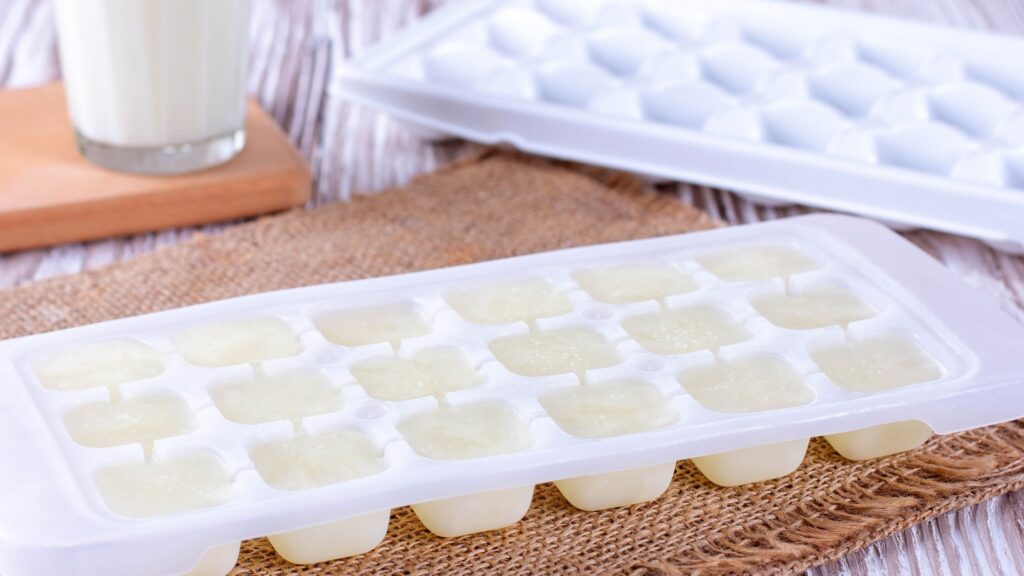I always have a carton of almond milk in my fridge, but sometimes I finish it before expiration. Sometimes I used to toss it out, but then I learned that you could freeze almond milk! There are several reasons why frozen almond milk is a good idea.

Can you freeze almond milk?
The answer is:
Yes, you can freeze almond milk to use in smoothies, shakes, and baking dishes. However, don’t drink frozen nut milk directly due to changes in taste and flavor. Instead, you can use it in cooking after blending.
How to freeze almond milk?
There are two methods to freeze almond milk.

In ice cube tray: To freeze almond milk, pour it into an ice cube tray and freeze for several hours. Once frozen, transfer the cubes to a freezer-safe bag or container. Store the pack in the freezer. It is my preferred method as you can thaw the amount of milk required.
Measure the amount of MLK that goes in each cube tray. It will help you take out the cubes according to your need for almond milk.
Directly in the container: You can freeze it in a container by pouring milk and freezing it. Only freeze milk in the container if you know that you will finish it whole after thawing.
Freeze almond milk in small containers as a batch. Keep some space in the container as milk will expand as it freezes.
How to thaw nutty milk?
You can use a few methods to thaw the almond milk according to your preference.
Thaw overnight in the fridge
The best way to thaw frozen almond milk is to transfer it to the fridge and melt it overnight. To thaw almond milk in ice cubes, move the tray to the refrigerator a night before needing almond milk.
Containers with larger amount of almond milk will need more time to thaw. Make sure you give them enough time to thaw.
In warm water
You can also place the milk container or ice cube tray in a bowl of warm water for about 15 minutes. Do not microwave frozen milk as it can cause hot spots and grainy milk.
Directly on stove
If you are making something with almond milk, you can transfer the ice cubes directly into the pan. I do this while preparing curries with almond milk as it is a great option if you are a vegan and don’t want to use dairy products.
What happens when you thaw frozen almond milk?
When you thaw the almond milk after freezing, it will separate. You will see a thinner liquid as the top layer and thicker milk at the bottom of the jar. This one will not give you desired results in smoothies or shakes.
To fix this, blend the milk for 15-20 seconds and you will have milk similar to fresh almond milk. Still, you will see a few changes in the appearance as there will be some bubbles on the top layer.
The milk will give you good results in baked recipes and other cooked dishes. I, however, would like like to drink frozen almond milk.
How to fix separated almond milk?
If your almond milk has separated into two layers after freezing, give it a good shake before using it. The ingredients will have settled during freezing, so you’ll need to mix them back together before using the milk.
Another suitable method is to blend the milk for 15-20 seconds in a blender before using it. It will help evenly distribute the ingredients and give you smooth, creamy milk.
Tips for using frozen nutty milk
Here are some tips to keep in mind when using frozen almond milk:
Blend before use: Shake well before using as the ingredients can separate during freezing.
Don’t drink directly: Frozen almond milk will be thicker than fresh milk, so it may not be suitable for drinking directly. In addition, the taste and flavor change slightly after thawing the frozen milk.
Use frozen almond milk within 3 months for the best quality.
For how long can you freeze almond milk?
You can keep frozen almond milk for up to 6 months, but the taste will decline as the time passes. After that, the quality of the milk will start to decline.
I prefer to use it within one month of storing in the freezer.
Use within a day or two after thawing the nut milk.
What are the benefits of freezing almond milk?
There are several benefits of freezing almond milk. One is that it extends the shelf life of the milk.
Two, frozen almond milk can help you save money. It is convenient to have almond milk on hand when you need it.
Finally, frozen almond milk can also help preserve flavor and nutrition.
How to use thawed almond milk?
There are many ways to use frosted almond milk.
- Smoothies: Use frozen almond milk cubes in your favorite smoothie recipe.
- Pancakes or waffles: Replace regular milk with frozen almond milk in your pancake or waffle batter.
- Creamy soups: Add a few cubes of frozen almond milk to your soup for a creamier texture.
- Oatmeal: Stir in some frozen almond milk when you’re cooking oatmeal for a richer flavor.
- Coffee or tea: Add a few cubes of frozen almond milk to your coffee or tea for a creamy beverage.
- Baked goods: When making muffins, bread, or cakes, replace some of the liquid with frozen almond milk. This will give your baked goods a richer flavor.
- Frozen treats: Use frozen almond milk in place of dairy milk when making ice cream, popsicles, or other frozen treats. You can also use it to make a healthy milkshake! Just add some bananas and almond milk to a blender and blend until smooth. Then add your favorite toppings and enjoy.
How long can you freeze this milk?
Almond milk will keep in the freezer for up to two months. Just make sure to store it in an airtight container, so it doesn’t absorb any freezer smells. And when you’re ready to use it, thaw the almond milk in the fridge overnight.

Can you freeze nut milk yogurt?
Yes, you can freeze nut milk yogurt. You can freeze it in an icecube tray and then store it in the freezer. Frozen Nut milk and nut milk products give good results while used in recipes and not taken.
Taste and flavor always differ from the fresh product.
To summarise
You can freeze almond milk and use defrosted almond milk in many dishes. Smoothies and shakes are a great option. Baked dishes give the same results with frozen almond milk as fresh milk.
So, if you have extra almond milk with you next time you have extra almond milk, don’t throw it. Freeze for later use.